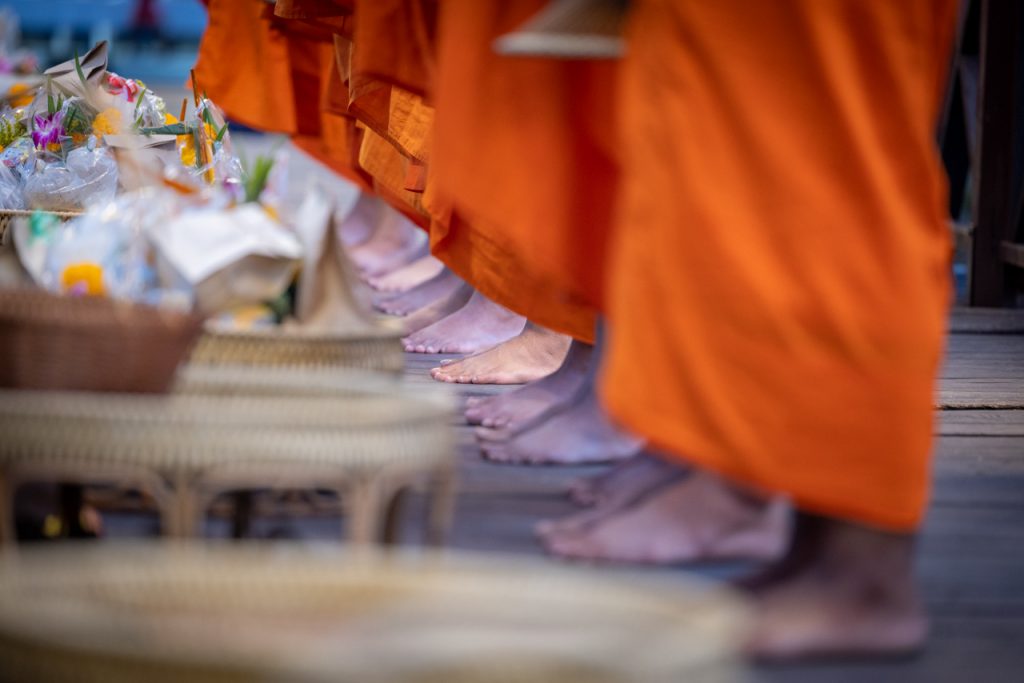On our travels in Asia, we have often curiously observed monks from a distance as they wander the streets to receive alms. In the northern Thai city of Sukhothai, we were invited by the local temple to participate in the ritual ourselves. Here we talk about our preparations and the experience, which was both a touching and slightly embarrassing affair.
Written by Mette / Photo by Martin
Translated from Danish
It is still dark as we head towards the city temple early in the morning. Above us, the crescent moon hangs like a luminous hammock strung out between the stars in the sky. It’s completely quiet here. Not even the rooster bothers to crow at this time of day.
When we travel in Asia, we almost always get up with the sun. We love the peaceful mornings when the temperature is cool, the light is golden, and there are only a few tourists at the main sights. But today we are still a little earlier than usual.
It is barely half past six and we are on our way to experience one of the most important daily rituals in Theravada Buddhism. A faith that dominates large parts of Southeast Asia and which historians believe was introduced as Thailand’s religion right here in Sukhothai over 700 years ago.
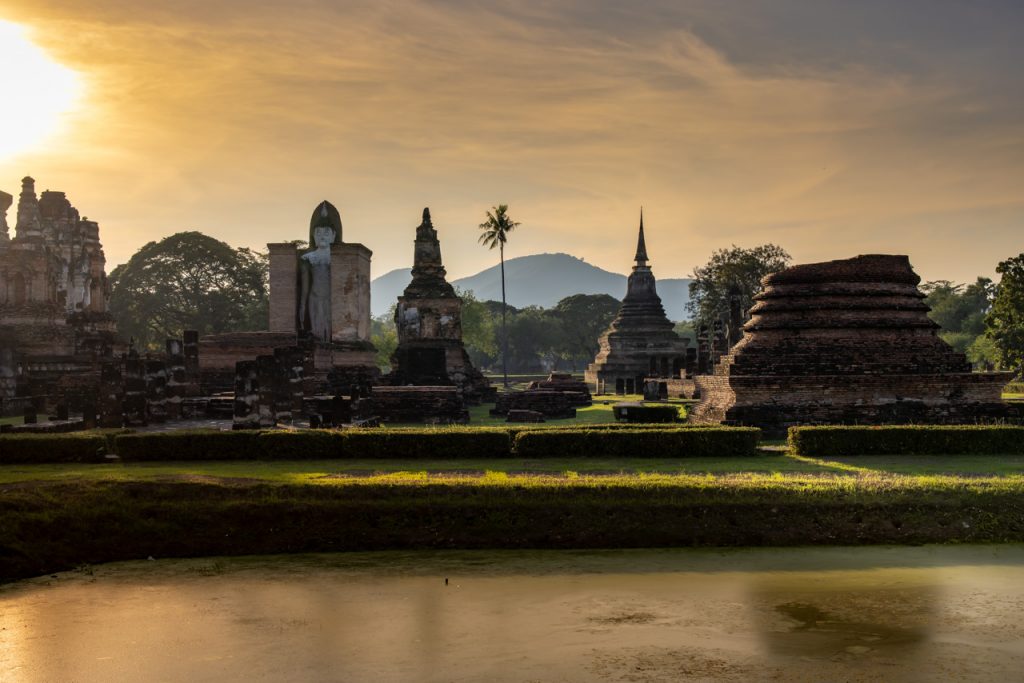
Amateurs shopping alms
“What do you think monks eat?” My question to Martin reveals my limited knowledge of temple life. We have often seen the orange-clad, crowned men walking around with bowls in their hands to receive food from the locals. But we have never given alms ourselves.
Almsgiving is a common morning ritual for all Buddhist monks in Thailand. Traditionally, owning anything or having paid work is against their rules. Therefore, they depend on what people donate to the temple or give them in their daily alms collection.
Here, too, in the small town of Old Sukhothai, the monks walk the streets of the town to receive alms. But in addition, they gather every morning at 6.20 a.m. at the city’s temple, Wat Traphang Thong.
Here they practice a special alms session so that both locals and visitors can experience an important part of the country’s religion – right where it has its historical roots. And that is the reason why Martin and I are now standing at a small, illuminated food stand that has miraculously materialized on the city’s main street in the early hours of the morning.
We are Buying ALMS for the monks
Next to us are locals buying today’s lunch on their way to work. The table is full of small transparent plastic bags with noodle dishes, curry soups, and pieces of fruit and cakes in synthetic colours.
I’m a little embarrassed that I didn’t google a monk menu beforehand. Monks certainly eat rice, but are they vegetarians? Now that the temple invites everyone – regardless of religion and nationality – to participate in the almsgiving ritual, we would like to show our respect in return. We want to give the monks something they look forward to sinking their teeth into for their only meal of the day.
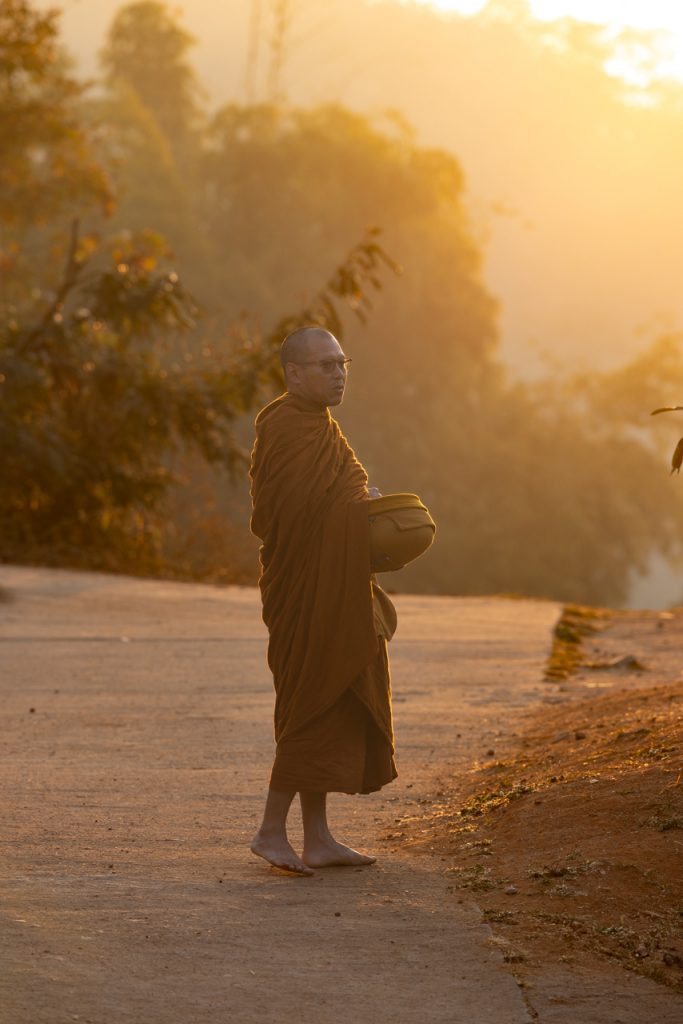
Beginner mistake on a streak
At the food stall, a young woman senses my incompetent behaviour in the queue and asks if she can help? I explain my puzzle, and she signs off with the iconic Thai character trait: a smile. She points to two bags of rice dishes and says in her best Thai English: “You buy.”
“Yes, yes,” I smile back but have the feeling that she didn’t understand my purpose for the purchase. In Thai culture, it is important not to lose face. They would rather answer incorrectly than be perceived as rude by not helping at all.
On the other side of the table, the Thai lady is quick and shows on a calculator that I have to pay 60 baht. An amount corresponding to 1,75 USD. “Kap khun ka”, thank you, I reply – and while I’m handing money over the table, Martin has spotted another stall a little further down the street.
“It’s a gift shop for monks”
… we conclude as we stand in front of the stall. It has conveniently emerged right next to the temple bridge, where the almsgiving ritual is to take place. On the table towers a small mountain of pre-packaged gift baskets. Ah, so our first shopping trip was a mistake: The locals thought we wanted to buy food for ourselves.
“You buy”, says the woman in the alms stall and lifts a wicker basket the size of a beer crate. There are 12 identical packages in it. All wrapped in gift paper and decorated with fresh flowers. Ehm, that’s probably a bit much, we think. Instead, we reach for a single package, and the woman mystified, takes our 100 baht.
“Why did she keep saying there are 12 monks?” Martin asks as we walk the last few meters to the temple bridge. And that question becomes the core of our beginner’s mistake number two.
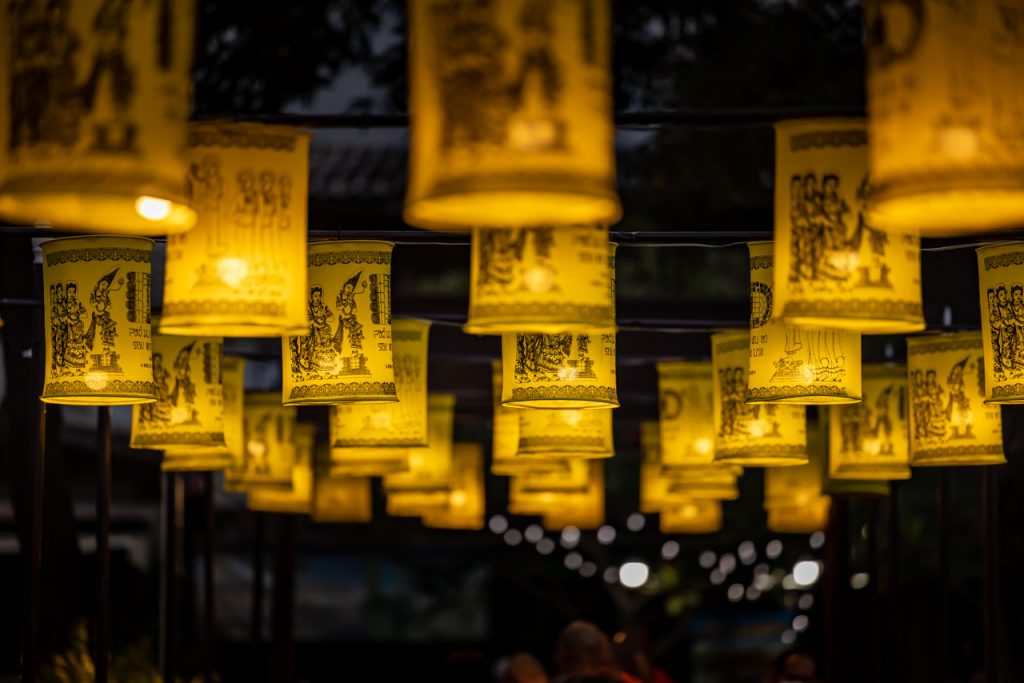
The art of arranging alms
On the bridge, a devout atmosphere rests below the yellow lanterns that illuminate the scene of the alms ritual. Several early birds have already taken their seats on the first mats that the temple staff has rolled out along the railing. In front of each mat stands a low tray table, and at the end of the bridge, the temple enthrones in the twilight.
“Shouldn’t we sit closer to the temple,” Martin suggests. I agree with that idea. Contrary to the locals who have placed themselves at the opposite end. But for us, it makes more sense that the best seats are close to the temple, where the monk procession begins.
And that’s how we make a hat trick in rookie mistakes, before the almsgiving has even started.
Together with an Australian family of four, we are the only tourists on the bridge among twenty to thirty locals. In hushed voices, people set about arranging their gifts for the monks. All kinds of treats are decorated with bows, crackling cellophane, and orange flowers. The small tables quickly disappear under the huge amount of alms, all while the whole thing is selfie-documented with great care.
At 6.20 AM everyone is ready. We have no idea what is going on, and in these kinds of situations, the best solution is always to mirror the locals. So, we sit on our knees, with bare feet, and folded hands in our laps. In front of us are our three little packed lunches, shouting at each other on a half-empty table.
Our arrangement is embarrassing in comparison with the lavish buffets of the locals. Here, the opposite of less is more prevails, and for the last few minutes, several people have been running in a shuttle between their reed mat and the gift shop. Martin and I can’t help but chuckle a bit from observing the scene, which is reminiscent of the final sprint at ‘The Great British Bake Off ‘: Who can pimp the prettiest alms?
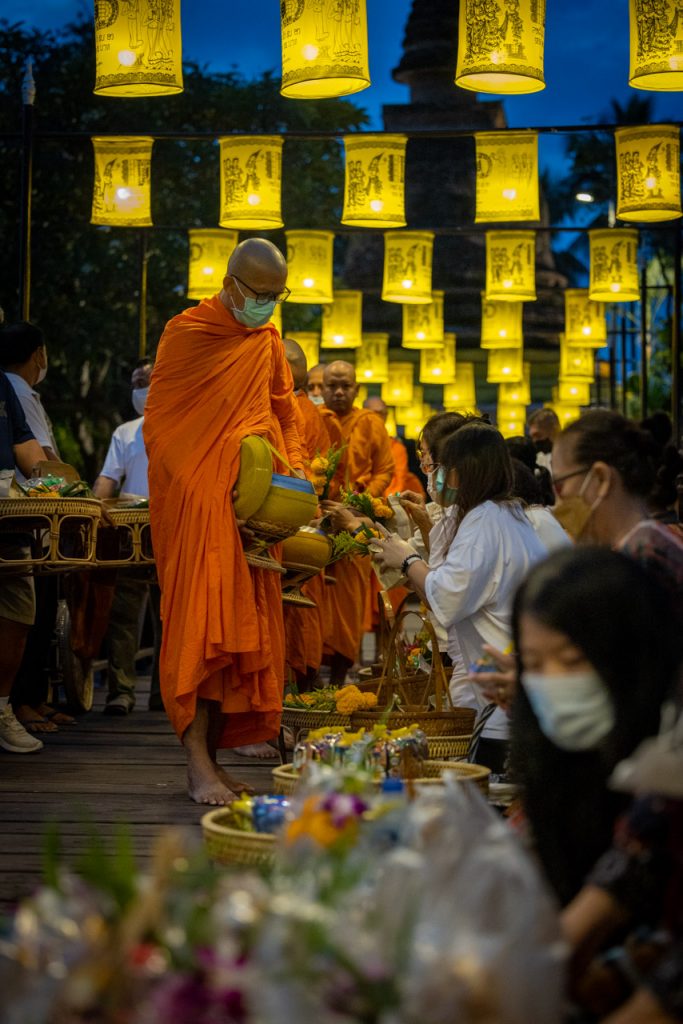
Twelve monks on a bridge
Suddenly a wave of silence rolls over the bridge. We can glimpse orange shadows moving along the temple, and one by one twelve monks step silently into the light. They walk in a row according to rank, each with their bowl hanging from a leather strap over their shoulder.
Fortunately, we are not among the very first. Thus, we have time to learn proper conduct before the first and oldest monk reaches us. With bowed head, our neighbour kneels before the monk and places a gift in his bowl. The monk then moves on to the next, and the ritual repeats itself until all twelve monks have been given alms.
Nobody says a word. But the reverence trembles in the air and makes a noiseless noise. The monks are superstars. Some of the locals even have family members on Facetime so they can experience the ceremony too. In Buddhism, it is an honour to be allowed to give and earn good karma. We do not know whether people achieve peace of mind this morning, which also is the purpose of the Buddhist ritual. But one thing is for sure:
We are going straight to hell!
Our table is gaping empty after the first three monks have passed. It’s toe-curlingly embarrassing and I’m on the verge of gnawing off my fingers and handing them one by one to each of the remaining monks. Instead, we try to kneel and kneel the very best we have learned until the parade of monks stops at the last table.
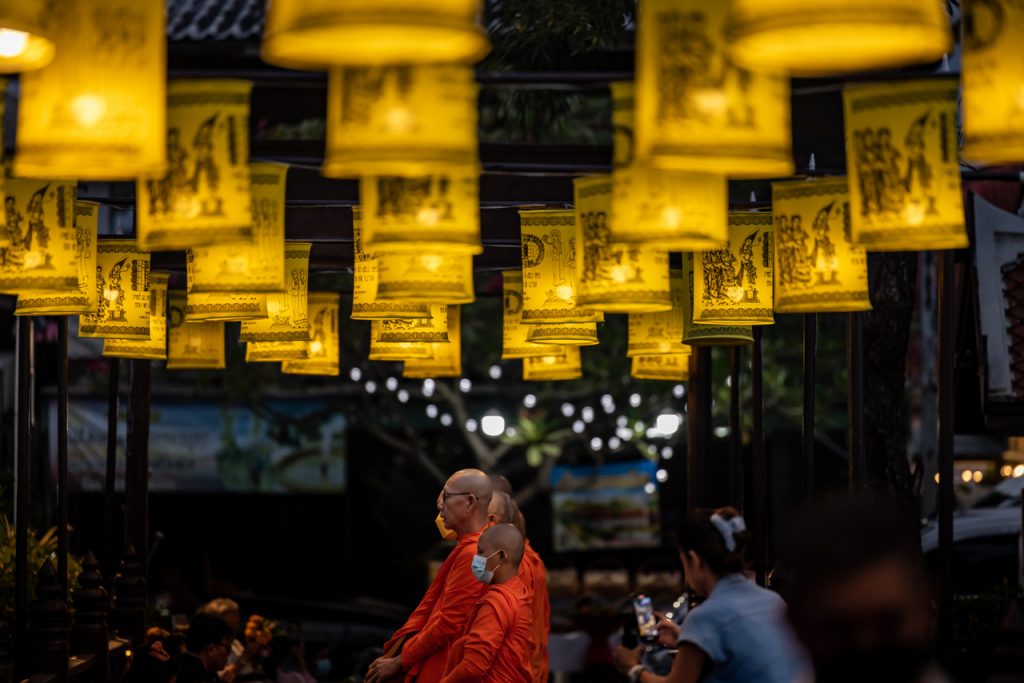
Blessing in sunrise
When monks receive alms on the street, they acknowledge each giver with a blessing. It takes place a little differently here on the bridge, where the monks first collect all the gifts and finally distribute a common blessing to all those present.
Ahhh! Now we understand why there was a tussle over the seats at the opposite end of the bridge. Here, the monks line up and end the day’s ritual by saying a longer blessing right in front of them.
The humming chant of the monks lasts barely a minute but feels like a long warm embrace – and in my quiet mind I hope they’ve included a sentence forgiving Martin and I for our three measly lunch packs.
Half an hour after the monks appeared, they are gone again. Above us, the sky has begun to lighten. A new day has started in the small town of Old Sukhothai, but for us it is unfortunately the last. In a few hours we will continue by bus to our next stop on the tour in Northern Thailand. We are going to Chiang Mai.
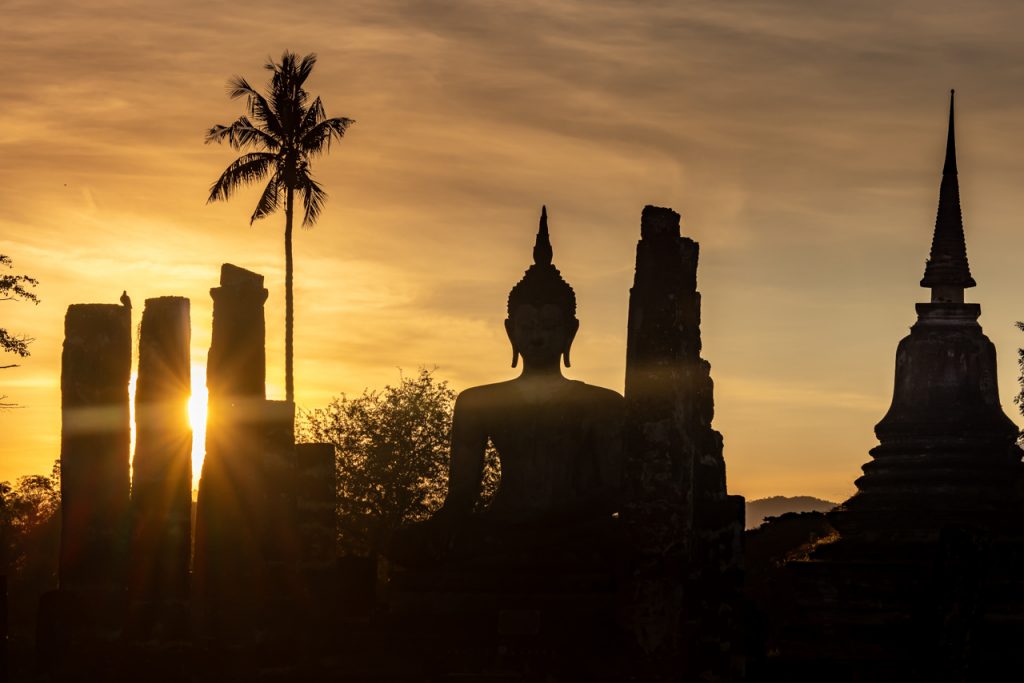
MINI GUIDE
Here’s how you can experience
giving alms to the monks in Sukhothai
Who can participate?
Everyone – regardless of religion or nationality – is invited to participate in the daily alms ceremony in Old Sukhothai. We felt very welcome, and the locals attending the ceremony were at least as curious about us as we were about them.
Is it worth coming?
Yes! The ceremony was originally created for tourists who want to know more about Buddhism and the daily life of the monks. Still, we experienced the alms collection as both authentic and atmospheric, as the majority of visitors were local or Thai tourists.
Where does it take place?
The almsgiving ritual takes place every morning on the wooden bridge that connects the city’s main street and the Wat Traphang Thong temple in Old Sukhothai. The temple is idyllically located on a small island in the middle of the lake and is worth a short visit if you haven’t already been.
What time?
At 6:00 a.m. – Temple employees begin to prepare mats and tray tables for those in attendance
At 6.20 a.m. – The monks arrive to collect alms
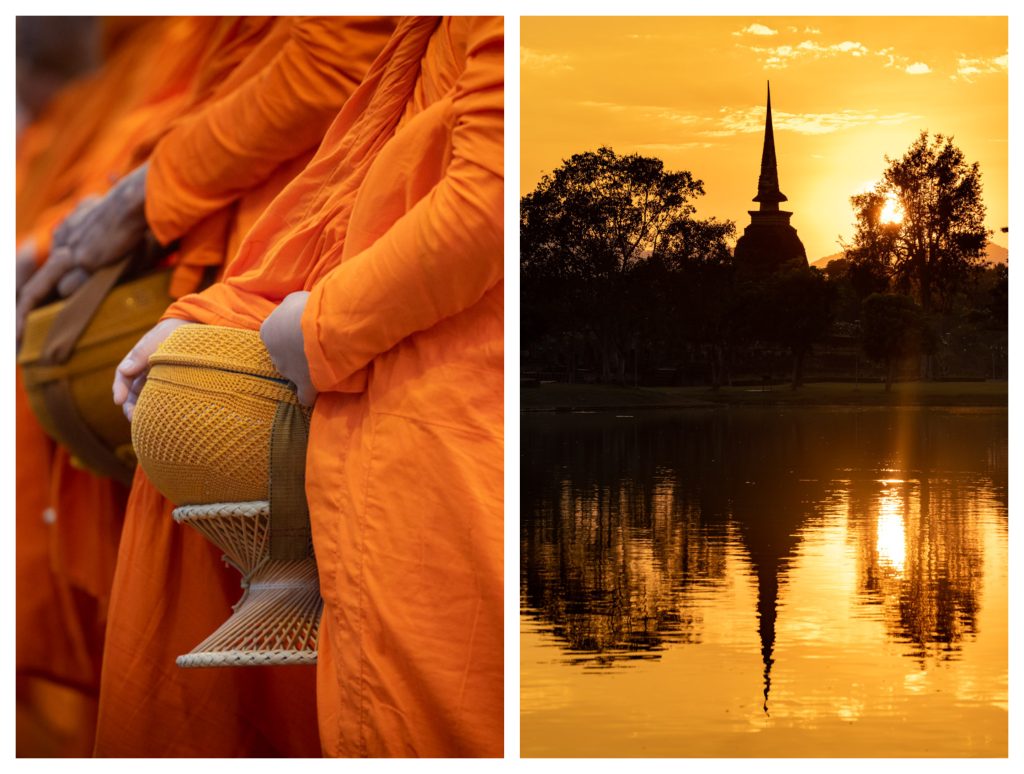
What should you bring?
It is up to the individual what they can and want to give to the monks. For this ceremony, giving food, flowers, juice, and water is most normal. It is good style if you bring a gift for each of the monks of the temple. When we were there, there were a total of 12 monks. Ask the locals for the number before you buy.
Where can you buy the gifts?
You can either buy food from the local morning market next to the temple. Or in the small stall that conveniently appears on the main street right in front of the temple bridge. Here you can buy ready-made packages and gift baskets specifically for the purpose. A package for a monk costs 100 baht (2022).
Dress code
Remember this is a religious ceremony. Both women and men must wear clothing that covers shoulders and knees. Take off your shoes when sitting on the mat.
Monk life
If you are curious to know more about monk life, you can also meet monks in Chiang Mai. Here, some of the largest temples invite you to a so-called ‘monk chat’, where you can ask anything, and the monks can at the same time hear about your life and practice their English.
